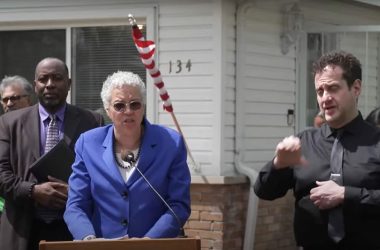Assistance Available to 240 Qualified Low- to Moderate-Income Buyers of Vacant Homes in Targeted Communities
 CHICAGO–(ENEWSPF)–March 6, 2014. Governor Pat Quinn today announced an innovative state program to help provide affordable homeownership opportunities for people and communities in need. The Illinois Homebuyer Rehabilitation Assistance Program will allow hard-working families buying vacant homes to apply for grants up to $25,000 to help encourage the reuse of vacant single-family properties. The announcement is part of Governor Quinn’s commitment to strengthen and stabilize Illinois communities by making homeownership more affordable.
CHICAGO–(ENEWSPF)–March 6, 2014. Governor Pat Quinn today announced an innovative state program to help provide affordable homeownership opportunities for people and communities in need. The Illinois Homebuyer Rehabilitation Assistance Program will allow hard-working families buying vacant homes to apply for grants up to $25,000 to help encourage the reuse of vacant single-family properties. The announcement is part of Governor Quinn’s commitment to strengthen and stabilize Illinois communities by making homeownership more affordable.
“All of our hard-working families deserve an opportunity for homeownership and this new program will help make that possible,” Governor Quinn said. “When we help more Illinois families afford homes, we also stabilize our communities and help drive economic growth across our state.”
The Illinois Housing Development Authority (IHDA), the state’s housing finance agency, allocated more than $6.6 million to 16 public and not-for-profit organizations to help 240 low- to moderate-income homebuyers. The program uses a holistic strategy to turn challenges into opportunities in targeted communities in suburban Chicago, Metro East, Rockford, Quad Cities, Peoria, Central Illinois and Southern Illinois.
“Governor Quinn is dedicated to homeownership strategies that prevent foreclosures, rehabilitate vacant properties and increase affordable opportunities for homeownership,” IHDA Executive Director Mary R. Kenney said. “Homeownership continues to be one of the most effective ways Illinois families can build wealth for their future and communities benefit from the economic impact.”
Returning properties to productive use helps communities by generating economic activity, including jobs and local revenue from property taxes and real estate taxes. Communities also benefit from increased consumer spending by contractors, as well as residents furnishing their new homes. For example, the sale of 500 homes supports 250 full-time jobs and generates almost $20 million in economic activity.
The program is not limited to first-time homebuyers. Qualifying low- to moderate-income homebuyers of vacant single-family homes must apply through the 16 organizations for acquisition costs, and up to $20,000 for rehabilitation for home modification repairs and improvements. Homebuyers who are at or below 50 percent of area median income (AMI) will qualify for up to $5,000, and buyers between 51 percent and 80 percent AMI will qualify for up to $3,000 for acquisition. Please see www.ihda.org for a list of income limits.
The new assistance can be paired with IHDA’s loan products, which feature secure 30-year fixed-rate loans and up to $10,000 in down payment assistance. Buyers must qualify based on income and purchase price limits, and can apply for the loan package through an IHDA-approved lender at www.ihda.org.
The program is funded through the Illinois Affordable Housing Trust Fund, which is generated from half of the state real estate transfer fee.
Governor Quinn has been a leader on affordable housing in Illinois and made a historic commitment of $130 million in state capital funds to create more affordable housing opportunities. The Governor has also worked to spur affordable housing homeownership and multifamily rental development by launching four new safe and affordable mortgage programs and by working to increase the rental options available to working families, seniors and persons with disabilities. Since 2009, 6,500 working families have been able to purchase a home affordably and 19,700 affordable rental units were created or preserved, generating 16,600 jobs and infusing $780 million into Illinois’ economy.
About the Illinois Housing Development Authority
IHDA (www.ihda.org) is a self-supporting state agency that finances the creation and the preservation of affordable housing across Illinois. Since its creation in 1967, IHDA has allocated $12.4 billion and financed approximately 240,000 affordable units across the state.
Source: illinois.gov








